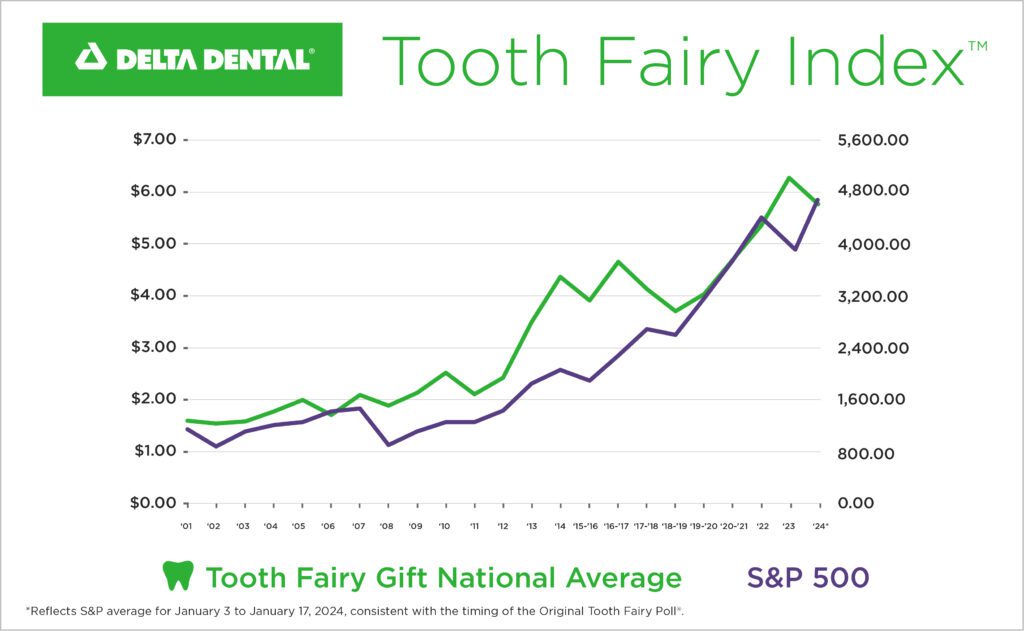By Mojo The Monkey
Tecumseh Ridge Dental’s Mascot and close personal friend of the Tooth Fairy
February is National Children’s Dental Health Month. For this occasion, we turned over our blog to resident Tecumseh Ridge Kids Expert, Mojo The Monkey.
2024 Tooth Fairy Update: Everything you need to know about the Tooth Fairy
The latest numbers don’t lie. The slowing U.S. inflation has now reached the Tooth Fairy.
After last year’s record high, the Tooth Fairy payout is slowing down. According to new Delta Dental findings from its 2024 Original Tooth Fairy Poll®, the average value of a single lost tooth over the past year has decreased by 6%, from $6.23 to $5.84. This marks the first year-over-year decline in Tooth Fairy payouts in five years.
Despite the first lost tooth usually fetching a higher value, the poll also found that the Tooth Fairy is being more frugal with this milestone, with the average value dropping from $7.29 to $7.09 over the past year.
The original post: Today – Feb. 28 – is National Tooth Fairy Day. Like every important mythical creature, the Tooth Fairy deserves his/her day in the limelight, and I, Mojo The Monkey, am here to illuminate you about my good old friend. Some people also claim National Tooth Fairy Day is Aug. 28, but I am reasonably sure those people are wrong.
What does the Tooth Fairy pay these days?
According to the 2024 “Original Tooth Fairy Poll” conducted by dental-benefit provider Delta Dental, the fairy is paying big bucks. The average cash gift for a tooth, according to the national survey of 1,000 parents taken in early 2024, is $7.09 . The rate has been on the rise over the last five years. If 7 bucks sound high to you, you are not alone. For most kids the going rate for a freshly pulled tooth is between 25 cents and $1. If the child showed special bravery while pulling the tooth, or the Tooth Fairy shows up a day late (these things happen), sometimes more is given. In some cases, she brings a small toy. This happens when the Tooth Fairy has made special arrangements with parents who requested a gift rather than cash. We have also heard of cases when the Tooth Fairy paid $10 or $20. That better was a grade-A tooth or perhaps a gold-capped chomper, in my humble opinion. Just, consider how badly little Zoe would feel when she learns that her BFF Chloe got a crisp 20 while she only received a dollar for her teeth. That’s why the Tooth Fairy likes to not go overboard, even for the best teeth. Fair is fair.
However, like the rest of us, inflation has not spared the Tooth Fairy. Delta Dental released a chart in 2024 illustrating the rate hike over the last two decades. And according to Delta Dental, their Tooth Fairy IndexTM reveals that the value of lost teeth is closely related to U.S. economic trends. In fact, for 17 of the past 20 years, the trend in average giving has tracked with the movement of the S&P 500.

Whom does the Tooth Fairy visit?
The Tooth Fairy arrives under the cover of night to collect the teeth of little children. Under the cloak of darkness, she enters the room, finds a tiny tooth under the pillow, and leaves – unnoticed. This sounds positively creepy. Yet, a visit by the Tooth Fairy is one of the most beloved rites of passage during childhood. The Tooth Fairy brings children money or a small toy before she flies off to an undisclosed location. Some children write letters to the Tooth Fairy, while other families have the Tooth Fairy leave letters encouraging better oral hygiene. It doesn’t matter if you are a good kid or bad. You put a tooth under the pillow, you get paid. However, it is said that Tooth Fairy pays better for healthier teeth.
What do we know about the Tooth Fairy?
Children have long capitalized on the loss of their baby teeth. The earliest recorded reference to the Tooth Fairy appeared in 1908 in a “Chicago Daily Tribune” Household Hints column. In this column, Lillian Brown first wrote that a child would tolerate the removal of a loose baby tooth if he learned about the Tooth Fairy. Duh! Who doesn’t know that? Tooth Fairies have been around for hundreds of years. Today’s Tooth Fairy is based on Western and Western-influenced cultures stories, and folklore, which tell that when children lose one of their baby teeth, they should place it underneath their pillow or on their bedside table and the Tooth Fairy will visit while they sleep, replacing the lost tooth with a small payment. The tradition of leaving a tooth under a pillow for the Tooth Fairy to collect is practiced in many countries, but not all. Some children around the world will collect their teeth in special tooth boxes or save them in other ways. And yes, you read right. Tooth Fairies. There is more than one… how else would you explain that she has turned up looking all different ways?
There are both boy and girl fairies. They are nearly impossible to catch. In fact, no child has ever successfully taken a photo of the Tooth Fairy, but many pre-schoolers have captured the Tooth Fairy in their art.
The Tooth Fairy is an essential worker
During the coronavirus pandemic in 2o20, adults and children alike wondered if the Tooth Fairy, too, would have to quarantine. Children across the world called on political leaders and health experts to address whether losing a tooth during the pandemic was bad timing.
Much to the relief of children worldwide, the Premier of Quebec and New Zealand Prime Minister assured kids that the tooth fairy is, indeed, an essential worker in April 2020. Dr. Anthony Fauci, director of the U.S. National Institute of Allergy and Infectious Diseases, soon followed suit with a guarantee of his own: The tooth fairy was not at risk of infection and is indeed immune to Covid-19.
What to do when the tooth is lost before the Tooth Fairy shows up?
We have experienced the panic when a child loses his tooth and then loses that tooth. Yes, it happens. Teeth have been swallowed, misplaced, flushed down the drain, or lost somewhere between school and home. For many kids, that’s a huge problem. No tooth. No money. But that’s not always the case. Many children have written a nice letter to the Tooth Fairy explaining what happened, and the Tooth Fairy still paid up.
Why did the Tooth Fairy not show up?
We have heard of rare cases when the Tooth Fairy failed to show up. It can happen. Sometimes she’s swamped with collecting teeth around the world or couldn’t make it in due to tricky access to the house. Or she made it in, but was unable to locate the tooth under a mountain of stuffed animals residing in the kid’s bed. It might also be that you stayed up a bit too late, and she couldn’t sneak in quietly. Rest assured, the Tooth Fairy never forgets, and she’ll definitely come by soon. Just place your tooth back under your pillow, tell a parent and get a good night’s sleep. She’ll make her visit before you know it.
How do you celebrate National Tooth Fairy Day?
Well, every family can decide this on their own. Make tooth-shaped cookies (and brush your teeth well after you eat them.) Talk about good oral health, or buy everyone a brand-new toothbrush. Kick back and watch The Tooth Fairy with Dwyane The Rock Johnson in the lead role. Or do all of the above.
Scholastic Books also has a great variety of books to read with the family such as The Night Before the Tooth Fairy. And here are some more great stories to share with the family.
- You Think It’s Easy Being the Tooth Fairy? by Sheri Bell-Rehwoldt
- How to Catch the Tooth Fairy by Adam Wallace
- Bear’s Loose Tooth by Karma Wilson
- Clark the Shark: Tooth Trouble by Bruce Hale
- Tooth Trouble by Jane Clarke
- Gilbert and the Lost Tooth by Diane deGroat
- The Night Before the Tooth Fairy by Natasha Wing
And now, my friends, you know all there is to know about the Tooth Fairy.
Signing off,
Your Kid-Expert Mojo
Read Mojo’s other blog about making dentist visits fun for kids.



